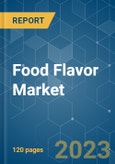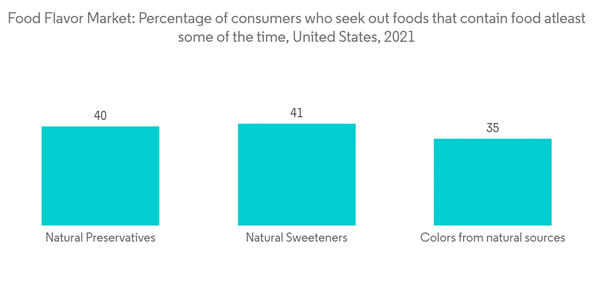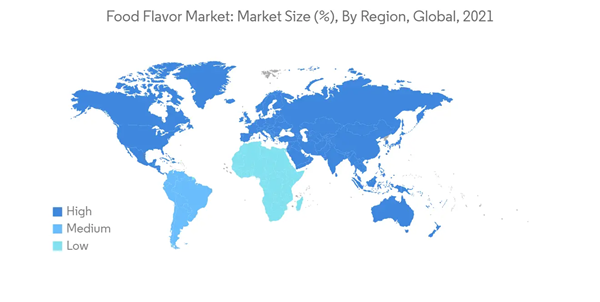Over the next five years, the food flavor market should register a CAGR of 4.8%.
One of the most important things driving the growth of the food flavor market is the rising demand for ready-to-eat foods, ready-to-drink beverages, snacks, frozen meals, and other processed foods.With more people living in cities, more women working, more middle-class people, and more money to spend, both developed and developing parts of the world are seeing a rise in the demand for processed and packaged food. This is making the need for packaging and processing solutions for food grow.Because of this, food additives are used a lot in processed and convenience foods to keep the freshness and taste of the food.
The demand for compounded flavors is also going up because there are more uses for them in food, exotic flavors are becoming more popular, and new products with exotic and unique flavors are coming out. People all over the world are getting more worried about how artificial ingredients and additives in food will affect their health in the long run. But people want ingredients that come from plants or are made from plants and help them live a healthy life. So, the high production of natural flavors is helping the market grow because people like to buy ingredients that are clearly labeled and don't contain harsh chemicals. Consumers are becoming more aware of the negative health effects of eating synthetic or artificial food additives like flavors, thanks to research projects and bans and limits put in place by governments. For example, eating these artificial ingredients can cause hyperkinesia, skin rashes, migraines, trouble sleeping, asthma, and stomach problems. These health issues have led to a consumer shift toward natural flavors. For instance, Organic India launched a new campaign in India called "Towards Healthy Eating with the Aim" in order to encourage children to eat healthily. Also, companies like Walmart have announced the promotion of natural additives as one of their goals by 2025.
To meet the growing demand for natural flavors, companies are making products without artificial flavorings and slowly switching to natural ingredients. For example, Edlong Corporation grew its line of real dairy-based flavors by putting more effort into applications, sensory characteristics, and research and development. The product line includes things like real cheese and buttermilk flavor profiles, which come from natural dairy and have different benefits. One of the main things that keeps people wanting natural flavor blends is their interest in foods with unusual or ethnic flavors. Natural flavorings are replacing artificial flavorings like benzophenone, ethyl acrylate, pyridine, and styrene in recent years due to their identification as carcinogens.
According to the World Data Atlas, France has the third highest per capita consumption of cheese after Denmark, Iceland, and Finland. Thus, manufacturers, such as Kerry Group and Flavorchem Corp., among others, are offering dairy flavors to meet the consumers’ everlasting demand for cheese. Also, functional food additives, such as natural flavors, are utilized in various culinary applications in Germany, including baked goods and other processed foods.
Compared to their European counterparts, Russian consumers are more aware of labeling rules than they used to be. This is because clean labeling is becoming more popular. On January 10, 2019, Russia notified the World Trade Organization (WTO) of draft amendment No. 2 to the Technical Regulation (TR) of the Customs Union, "Safety Requirements for Food Additives, Flavorings, and Technological Aids." This change adds and changes a number of definitions for food additives and sets new rules for these products. Thus, the demand for clean labels has been one of the underlying factors driving the market for natural flavors in Russia.
This product will be delivered within 2 business days.
One of the most important things driving the growth of the food flavor market is the rising demand for ready-to-eat foods, ready-to-drink beverages, snacks, frozen meals, and other processed foods.With more people living in cities, more women working, more middle-class people, and more money to spend, both developed and developing parts of the world are seeing a rise in the demand for processed and packaged food. This is making the need for packaging and processing solutions for food grow.Because of this, food additives are used a lot in processed and convenience foods to keep the freshness and taste of the food.
The demand for compounded flavors is also going up because there are more uses for them in food, exotic flavors are becoming more popular, and new products with exotic and unique flavors are coming out. People all over the world are getting more worried about how artificial ingredients and additives in food will affect their health in the long run. But people want ingredients that come from plants or are made from plants and help them live a healthy life. So, the high production of natural flavors is helping the market grow because people like to buy ingredients that are clearly labeled and don't contain harsh chemicals. Consumers are becoming more aware of the negative health effects of eating synthetic or artificial food additives like flavors, thanks to research projects and bans and limits put in place by governments. For example, eating these artificial ingredients can cause hyperkinesia, skin rashes, migraines, trouble sleeping, asthma, and stomach problems. These health issues have led to a consumer shift toward natural flavors. For instance, Organic India launched a new campaign in India called "Towards Healthy Eating with the Aim" in order to encourage children to eat healthily. Also, companies like Walmart have announced the promotion of natural additives as one of their goals by 2025.
Food Flavor Market Trends
Rising Demand for Natural Ingredients/Flavors
‘Clean labeling" is no longer a trend but has become a highly rated consumer demand that the global food industry is responding to by putting additional emphasis on these aspects during the processing of a food product. Consumers are becoming more aware of the adverse health effects associated with the consumption of various synthetic or artificial food additives, owing to various research projects as well as bans and limits introduced by governments. Such a preference shift towards clean label and natural ingredients is primarily due to government authorities, such as the WHO, FDA, EFSA, and FSSAI, who have recognized the hazardous effects of these ingredients and laid down guidelines for the use of such ingredients in food products with which food and beverage manufacturers must comply. For instance, the FDA removed six synthetic flavoring substances and flavor enhancers (adjuvants) from the food additives list. The six flavoring substances include synthetically derived benzophenone, ethyl acrylate, eugenyl methyl ether (methyl eugenol), myrcene, pulegone, and pyridine. Additionally, Natural Products Canada announced a USD 50 billion investment fund in 2021 to help early-stage Canadian businesses create naturally derived substitutes for synthetic products in order to boost the penetration of natural ingredients and replace their synthetic counterparts. A significant number of consumers have gained interest in purchasing clean-label goods, which offer a wide scope for naturally sourced ingredients, hence propelling the demand for natural food flavors.To meet the growing demand for natural flavors, companies are making products without artificial flavorings and slowly switching to natural ingredients. For example, Edlong Corporation grew its line of real dairy-based flavors by putting more effort into applications, sensory characteristics, and research and development. The product line includes things like real cheese and buttermilk flavor profiles, which come from natural dairy and have different benefits. One of the main things that keeps people wanting natural flavor blends is their interest in foods with unusual or ethnic flavors. Natural flavorings are replacing artificial flavorings like benzophenone, ethyl acrylate, pyridine, and styrene in recent years due to their identification as carcinogens.
Europe Holds the Major Share in Food Flavor Market
The United Kingdom continues to dominate the natural food flavor market as there is a continuous demand for organic products in the country. For instance, the sales of organic foods and drinks in the United Kingdom increased at a significant rate in the last few years. One in every three products launched in the United Kingdom contains natural food ingredients, including natural flavors.According to the World Data Atlas, France has the third highest per capita consumption of cheese after Denmark, Iceland, and Finland. Thus, manufacturers, such as Kerry Group and Flavorchem Corp., among others, are offering dairy flavors to meet the consumers’ everlasting demand for cheese. Also, functional food additives, such as natural flavors, are utilized in various culinary applications in Germany, including baked goods and other processed foods.
Compared to their European counterparts, Russian consumers are more aware of labeling rules than they used to be. This is because clean labeling is becoming more popular. On January 10, 2019, Russia notified the World Trade Organization (WTO) of draft amendment No. 2 to the Technical Regulation (TR) of the Customs Union, "Safety Requirements for Food Additives, Flavorings, and Technological Aids." This change adds and changes a number of definitions for food additives and sets new rules for these products. Thus, the demand for clean labels has been one of the underlying factors driving the market for natural flavors in Russia.
Food Flavor Industry Overview
The global food flavor market is competitive. Kerry Group, Givaudan, Cargill Inc., Archer Daniels Midland Company, and Symrise AG are a few of the key players present in the market. Major companies are adopting strategies, such as introducing clean labels and organic flavor ranges and acquiring and partnering with local players to increase market penetration in untapped markets. The launch of new commodities may assist giant manufacturers in boosting sales, grasping consumers’ attention, and enhancing their brand value. Several other players, along with the major players, are concentrating on online distribution channels for their online promotion and branding of their products in order to expand their geographic reach and increase their customer base.Additional Benefits:
- The market estimate (ME) sheet in Excel format
- 3 months of analyst support
This product will be delivered within 2 business days.
Table of Contents
1 INTRODUCTION
4 MARKET DYNAMICS
5 MARKET SEGMENTATION
6 COMPETITIVE LANDSCAPE
Companies Mentioned (Partial List)
A selection of companies mentioned in this report includes, but is not limited to:
- Koninklijke DSM NV
- Kerry Group PLC
- BASF SE
- Archer Daniels Midland (ADM)
- Givaudan SA
- Firmenich SA
- Corbion NV
- Sensient Technologies
- Symrise AG
- Cargill Inc.
Methodology

LOADING...










